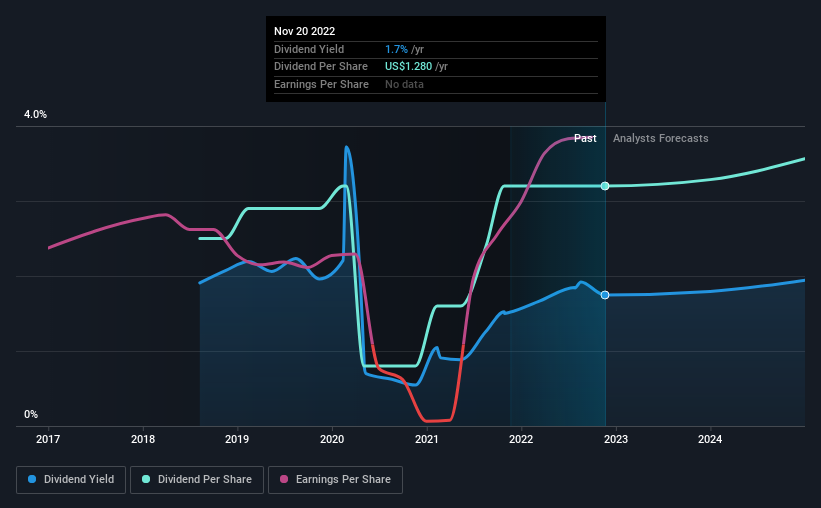- United States
- /
- Hospitality
- /
- NYSE:WH
Wyndham Hotels & Resorts (NYSE:WH) Is Paying Out A Dividend Of $0.32

The board of Wyndham Hotels & Resorts, Inc. (NYSE:WH) has announced that it will pay a dividend of $0.32 per share on the 28th of December. This means the dividend yield will be fairly typical at 1.7%.
Our analysis indicates that WH is potentially undervalued!
Wyndham Hotels & Resorts' Dividend Is Well Covered By Earnings
While it is always good to see a solid dividend yield, we should also consider whether the payment is feasible. However, prior to this announcement, Wyndham Hotels & Resorts' dividend was comfortably covered by both cash flow and earnings. This means that most of what the business earns is being used to help it grow.
Over the next year, EPS is forecast to expand by 24.0%. If the dividend continues on this path, the payout ratio could be 28% by next year, which we think can be pretty sustainable going forward.

Wyndham Hotels & Resorts' Dividend Has Lacked Consistency
Looking back, the dividend has been unstable but with a relatively short history, we think it may be a bit early to draw conclusions about long term dividend sustainability. Since 2018, the annual payment back then was $1.00, compared to the most recent full-year payment of $1.28. This implies that the company grew its distributions at a yearly rate of about 6.4% over that duration. It's good to see the dividend growing at a decent rate, but the dividend has been cut at least once in the past. Wyndham Hotels & Resorts might have put its house in order since then, but we remain cautious.
The Dividend Looks Likely To Grow
With a relatively unstable dividend, it's even more important to see if earnings per share is growing. We are encouraged to see that Wyndham Hotels & Resorts has grown earnings per share at 11% per year over the past five years. With a decent amount of growth and a low payout ratio, we think this bodes well for Wyndham Hotels & Resorts' prospects of growing its dividend payments in the future.
We Really Like Wyndham Hotels & Resorts' Dividend
In summary, it is good to see that the dividend is staying consistent, and we don't think there is any reason to suspect this might change over the medium term. Earnings are easily covering distributions, and the company is generating plenty of cash. Taking this all into consideration, this looks like it could be a good dividend opportunity.
Investors generally tend to favour companies with a consistent, stable dividend policy as opposed to those operating an irregular one. Still, investors need to consider a host of other factors, apart from dividend payments, when analysing a company. Taking the debate a bit further, we've identified 3 warning signs for Wyndham Hotels & Resorts that investors need to be conscious of moving forward. Is Wyndham Hotels & Resorts not quite the opportunity you were looking for? Why not check out our selection of top dividend stocks.
Valuation is complex, but we're here to simplify it.
Discover if Wyndham Hotels & Resorts might be undervalued or overvalued with our detailed analysis, featuring fair value estimates, potential risks, dividends, insider trades, and its financial condition.
Access Free AnalysisHave feedback on this article? Concerned about the content? Get in touch with us directly. Alternatively, email editorial-team (at) simplywallst.com.
This article by Simply Wall St is general in nature. We provide commentary based on historical data and analyst forecasts only using an unbiased methodology and our articles are not intended to be financial advice. It does not constitute a recommendation to buy or sell any stock, and does not take account of your objectives, or your financial situation. We aim to bring you long-term focused analysis driven by fundamental data. Note that our analysis may not factor in the latest price-sensitive company announcements or qualitative material. Simply Wall St has no position in any stocks mentioned.
About NYSE:WH
Wyndham Hotels & Resorts
Operates as a hotel franchisor in the United States and internationally.
Fair value second-rate dividend payer.


